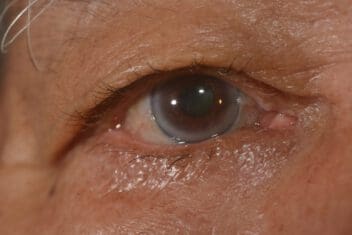
Medically Reviewed by Lee R. Katzman, M.D. NVISION Surgeon
Corneal Arcus: Causes & Treatment Options
Home / Eye Conditions & Eye Diseases /
Last Updated:

Medically Reviewed by Lee R. Katzman, M.D. NVISION Surgeon
Table of Contents
Corneal arcus is a harmless condition in which a person develops rings around their irises, giving the appearance of having two eye colors.
It can sometimes signal problems with high levels of cholesterol, but it is generally only of real concern when corneal arcus develops in people under age 40.
What Is Corneal Arcus?
Corneal Arcus is a condition characterized by a ring formation around the cornea of the eye. This ring often appears in shades of white, gray, or light blue and is mostly composed of cholesterol deposits.
In older adults, Corneal Arcus is usually a benign sign of aging and is referred to as arcus senilis. However, in younger individuals, it can be a sign of underlying health issues such as high cholesterol, and in such cases, it’s known as arcus juvenilis.
You deserve clear vision. We can help.
With 135+ locations and over 2.5 million procedures performed, our board-certified eye surgeons deliver results you can trust.
Your journey to better vision starts here.
Corneal Arcus does not affect vision, and there is no specific treatment for the condition itself. However, if it signals underlying health problems, medical intervention may be necessary to address those concerns.
Arcus Senilis: A Common Sign of Aging
Arcus senilis is a specific form of corneal arcus that frequently occurs in individuals over the age of 60. It’s characterized by a whitish, grey, or bluish ring that forms around the cornea. This ring is caused by lipid deposits, and although it may be noticeable, it does not affect vision or eye health.
For older adults, arcus senilis is typically not a cause for concern, and it is considered a benign age-related change. It does not necessarily indicate high cholesterol or other underlying health issues in this age group. Regular eye check-ups are recommended to monitor overall eye health, but specific treatment for Arcus Senilis is not needed.
Here’s a closer look at how arcus senilis compares to arcus juvenilis:
| Arcus Senilis | Arcus Juvenilis | |
|---|---|---|
| Age Group | 60 years and older | Under 40 years |
| Appearance | Whitish, grey, or bluish ring | Similar appearance |
| Causes | Age-related lipid deposits | Rapid cholesterol buildup |
| Health Concerns | Typically none | Potential health issue |
| Effect on Vision | No effect on vision | No effect on vision |
| Treatment Required? | No | Treatment of underlying health issues if present |
Signs & Symptoms of Corneal Arcus

Corneal arcus is characterized by a ring, usually white, gray, or light blue, around the edge of the cornea. Because this ring may layer over your iris, it sometimes creates the illusion that a person has two eye colors.
Interestingly, this is more or less the only direct sign of corneal arcus. Although it sometimes signals other problems, it can also result from the natural aging process.
Three groups of people are more likely to develop these rings, including African Americans, men, and people with a family history of high cholesterol.
Causes of Corneal Arcus
The ring around one’s iris is mostly composed of cholesterol, although it is not necessarily caused by a bad diet or high cholesterol levels. Many people develop these rings as they get older even while in normal health. When this happens, the condition is called arcus senilis.
Young people can develop corneal arcus, which is called arcus juvenilis. When this happens, it means the buildup of cholesterol happened much faster, and it generally signals a health problem. If a young person has developed corneal arcus, it is a good idea to visit an eye doctor and have them find the likely cause of the rings.
Broadly, fat buildup in the eye causes corneal arcus. The faster the ring forms, the more likely it represents signs of a potential health issue.
Family history can play a part in high cholesterol levels. As such, it can also play a part in developing corneal arcus.
How Does It Affect Your Vision & Health?
Corneal arcus has no known effect on a person’s vision. The ring may overlap with the iris, but you don’t see out of your iris. Vision occurs through the pupil, and the ring doesn’t develop over with this condition.
Some evidence suggests that iris color can impact a person’s light sensitivity, but the effect corneal arcus may have on this, if any, would be almost impossible to notice in a non-clinical setting.
Researchers have mixed conclusions about whether corneal arcus on its own is a risk factor for coronary heart disease. As a matter of course, it is a good idea for people who have corneal arcus to have a doctor check them for other signs of heart disease, as there is no downside to doing so.
Problems such as hypercholesterolemia may get caught in their early stages as a result, reducing the potential damage they can cause a patient and making treatment easier.
Corneal arcus is most concerning in children, teenagers, and young adults. While the rings themselves still don’t affect your health, they mean an individual likely has problems with high cholesterol.
Note that some babies may have a bluish ring around their iris, but this is due to a thin sclera and will disappear as they age. It is not the same as arcus juvenilis and doesn’t signal any of the noted health risks.
You deserve clear vision. We can help.
With 135+ locations and over 2.5 million procedures performed, our board-certified eye surgeons deliver results you can trust.
Your journey to better vision starts here.
Diagnosis of Corneal Arcus
An ophthalmologist can often easily see when a patient has corneal arcus, but they can also use a slit-lamp microscope to look more closely.
If a patient has corneal arcus, they may order further tests to check for coronary heart risks. This may involve a blood test.
Corneal Arcus Treatment
Virtually all medical literature notes corneal arcus doesn’t warrant treatment. There is no known way to “cure” the condition either. Eye surgery is complex and has notable risks. Research on ways to remove corneal arcus rings is minimal to nonexistent.
If a person’s corneal arcus signals high cholesterol levels or similar health risks, a doctor may help them develop a treatment plan to combat those issues. However, this will not treat the corneal arcus itself.
Can Corneal Arcus Be Reversed?
Corneal arcus rarely regresses, even if a patient lowers their cholesterol levels and practices a healthy lifestyle.
Notably, many people overestimate how these rings might affect their appearance. The rings of corneal arcus patients aren’t unattractive to most onlookers, just different. Even healthy bodies contain and use fats like cholesterol; these things only signal an issue in excess.
The rings also don’t necessarily signal any other health issue in a person. Even if one’s cholesterol levels are high, the condition isn’t so well-known by the public that the average person would make the connection without explanation.
Corneal Arcus FAQs
How common is corneal arcus?
Research shows that corneal arcus is more common than many might expect. In a screening of 500 patients, corneal arcus was present in the following:
- 28% (56 out of 200) of patients between 41 and 50 years old
- 44.9% (75 out of 167) of patients between 51 and 60 years old
- 69.7% (60 out of 86) of patients between 61 and 70 years old
- 72.3% (34 out of 47) of patients over 70 years old
While this is a relatively small sample size, it does help illustrate that most people develop corneal arcus if they live into old age.
How can corneal arcus be cured?
There is no known cure for corneal arcus. Many people find this disappointing, as the rings around the irises undeniably change aesthetic appearance. However, the current recommendation is that doctors reassure patients with the correct assertion that many, possibly most, people are either indifferent to corneal arcus rings or think they give a unique, striking appearance to the eye.
What is meant by “cholesterol rings”?
The ring present in corneal arcus patients is made of fats, called lipids. The most prevalent of these fats is cholesterol. As such, calling these rings cholesterol rings is arguably a simplification, but not wholly inaccurate.
You deserve clear vision. We can help.
With 135+ locations and over 2.5 million procedures performed, our board-certified eye surgeons deliver results you can trust.
Your journey to better vision starts here.
References
- Arcus Senilis. (August 2021). Treasure Island (FL).
- Corneal Arcus as Coronary Artery Disease Risk Factor. (August 2007). Atherosclerosis.
- Familial Hypercholesterolemia. (June 2020). MedlinePlus.
- Iris Color and Visual Functions. (January 2013). Graefe’s Archive for Clinical and Experimental Ophthalmology.
- Significance of Corneal Arcus. (April 2015). Journal of Pharmacy & Bioallied Sciences.
- What Is Arcus Senilis? (April 2019). American Academy of Ophthalmology.
- Prevalence of Corneal Arcus and Associated Factors in a German Population—Results From the Gutenberg Health Study. (September 2021). PLOS ONE.

Originally from New York, Lee R. Katzman, M.D. is a board certified Cornea Specialist and active Fellow of the American Academy of Ophthalmology.He has performed thousands of refractive surgical procedures and has been honored with numerous San Diego Top Doctors awards.
This content is for informational purposes only. It may have been reviewed by a licensed physician, but is not intended to serve as a substitute for professional medical advice. Always consult your healthcare provider with any health concerns. For more, read our Privacy Policy and Editorial Policy.
